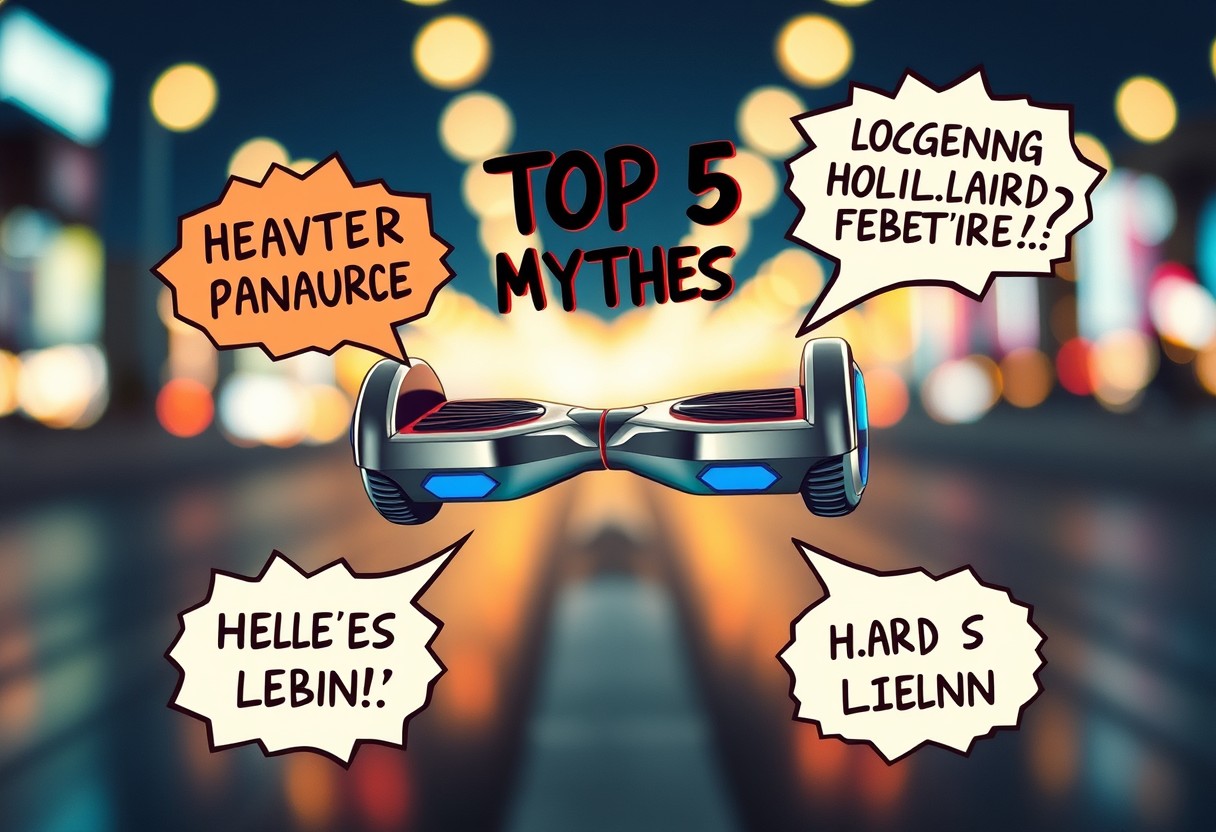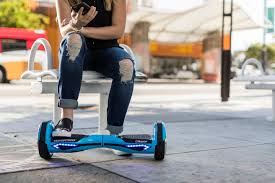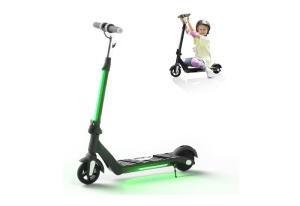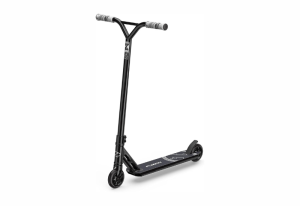Many enthusiasts and new users alike find themselves misled by common hoverboard misconceptions. In this informative guide, you will discover the truth behind the myths that can affect your safety and enjoyment. From fears of fire hazards to questions about age restrictions, we will clarify these dangerous misconceptions and present the facts that showcase the positive benefits of hoverboards. Arm yourself with knowledge and ride with confidence as we debunk the top 5 hoverboard myths that could be holding you back.
Table of Contents
ToggleUnderstanding Hoverboards
For anyone intrigued by the world of personal transportation, understanding hoverboards is necessary. These self-balancing scooters offer a unique blend of technology and fun, making them a popular choice for both kids and adults. By understanding how hoverboards work and their historical context, you can make an informed decision when considering one for yourself or as a gift.
Definition and Functionality
To appreciate hoverboards, you need to know what they are. A hoverboard is a two-wheeled, self-balancing electric scooter that allows riders to move around by shifting their body weight. The board typically consists of a platform for your feet, a battery for power, and sensors that detect your movements. When you lean forward, the hoverboard accelerates, and when you lean back, it slows down or goes in reverse. This intuitive design makes it easy for anyone to pick up and ride, though mastering it may take a bit of practice.
To operate a hoverboard, you simply step onto the platform and allow the onboard sensors to detect your weight distribution. The greater your lean, the faster you move in that direction. Additionally, hoverboards are equipped with safety features such as LED lights and non-slip footpads, enhancing your overall riding experience.
Brief History of Hoverboards
Hoverboards burst onto the scene in the early 2010s, quickly becoming a popular mode of personal transportation. This innovation captured your imagination, reminiscent of the hoverboards seen in science-fiction movies like “Back to the Future.” However, the technology behind hoverboards has roots that date back decades, involving advancements in robotics and electric motors.
History shows that the first self-balancing scooter prototype emerged in the early 2000s, but it wasn’t until companies started marketing sleek designs and improved battery technology that hoverboards truly gained traction. Concerns arose regarding hoverboard safety, particularly issues with overheating batteries that caused some models to catch fire. Nevertheless, the joy and convenience hoverboards offer, combined with ongoing improvements in safety standards, have helped them secure a place as a popular recreational tool for many.
Common Myths About Hoverboards
Some people hold onto widespread beliefs about hoverboards that simply aren’t true. These myths can prevent you from enjoying all the benefits that these innovative devices have to offer. For instance, you might have heard that riding a hoverboard enhances your physical strength and coordination. In fact, How riding a hoverboard makes you stronger reveals fascinating insights into how using a hoverboard can boost your core strength and balance—aspects that are beneficial no matter your age.
Myth 1: Hoverboards Are Only for Kids
On the surface, it might seem like hoverboards are designed primarily for children, leading many adults to shy away from them. However, this misconception overlooks the fact that hoverboarding can be enjoyed by people of all ages. They’ve grown into a popular recreational activity among teenagers and adults alike, making them versatile and suitable for various demographics. Many adults find that hoverboarding is a fun way to stay active while enjoying some outdoor leisure time.
Furthermore, hoverboards come in various models that cater to different weight limits and skill levels, ensuring that you can find one perfect for your needs. Don’t let the notion that hoverboards are “just for kids” hold you back from experiencing the thrill and benefits of riding.
Myth 2: Hoverboards Are Dangerous and Unsafe
Kids often hear horror stories about hoverboard accidents, leading to the belief that these devices are inherently dangerous. While it’s true that improper use can result in injuries, the same can be said for many sports and recreational activities. With appropriate precautions, such as wearing safety gear and following manufacturer guidelines, hoverboarding can be safe and enjoyable.
Myths surrounding hoverboards often stem from media coverage of rare accidents rather than the broader safety record of these devices. To keep your ride safe, always choose a reputable brand with robust safety features. This includes UL certification, which ensures that the hoverboard meets safety standards and reduces the risk of battery-related issues.
Myth 3: All Hoverboards Are the Same
On the contrary, hoverboards vary greatly in terms of quality, features, and performance. Some models offer advanced features like Bluetooth connectivity, built-in speakers, and different speed modes, catering to different preferences and riding styles. The materials used in construction can also affect durability, weight capacity, and overall safety, so it’s important to do your research before purchasing one.
The differences extend beyond just the aesthetic aspects; some hoverboards are designed specifically for off-road use, while others excel on smooth pavements. Whether you’re seeking a durable ride for casual cruising or heavy-duty options for rough terrain, you can find a hoverboard that fits your lifestyle.
Myth 4: Hoverboards Can Only Be Used on Smooth Surfaces
Surfaces that provide a stable and flat area for riding are undeniably favorable, but this belief suggests you can’t have a thrilling hoverboard experience elsewhere. In reality, many hoverboards are designed for various conditions, including uneven terrains. Off-road hoverboards come equipped with larger, rugged wheels and enhanced suspension systems for smoother rides, allowing you to take your hoverboarding skills to diverse environments.
Hoverboards can handle more than just concrete sidewalks and pavement. While safety considerations are important, including knowing your limits and wearing protective gear, you shouldn’t feel restrained by the myth that hoverboards are limited to flat surfaces. By choosing an appropriate model and practicing caution, you can expand your hoverboard adventures.
Myth 5: Hoverboards Are Just a Fad
Only time will tell if hoverboards remain popular, but dismissing them as a temporary trend fails to recognize their rising functionality and versatility. As technology continues to advance, hoverboards are becoming more innovative, which further solidifies their place in transportation and recreational activities. They serve not only as entertainment but also as a convenient, eco-friendly alternative for short commutes.
Hoverboards have established a dedicated user base and have even been integrated into various community events, competitions, and fitness regimes. When you think about their potential for personal transportation and the fun they bring, it’s clear that hoverboards are more than just a passing trend—they’re here to stay.
Safety Features in Modern Hoverboards
Despite some negative perceptions surrounding hoverboard safety, modern models are equipped with an array of advanced safety features designed to protect users. From rigorous testing standards to enhanced technology, today’s hoverboards are more reliable than ever before, ensuring a smoother and safer riding experience. Understanding these features can alleviate concerns and help you make informed decisions when choosing a hoverboard.
UL Certification and Quality Standards
Certification is a significant factor to consider when evaluating hoverboard safety. The UL 2272 certification signifies that the hoverboard has undergone extensive testing for electrical and fire safety, ensuring that it meets high industry standards. When a hoverboard displays this certification, you can have confidence that it has been evaluated for potential fire hazards and that the materials used are safer compared to non-certified models.
In addition to UL certification, various hoverboards are also subject to further quality standards concerning their design and production. You should always check for other certifications, such as ISO or CE marks, as these indicators imply adherence to global safety and manufacturing standards. By selecting a hoverboard that meets these rigorous criteria, you minimize the risks associated with less reputable brands.
Battery Safety and Management Systems
On the topic of battery safety, modern hoverboards come equipped with sophisticated Battery Management Systems (BMS) that help monitor and control battery performance. These systems prevent overcharging, overheating, and short-circuiting, reducing the chances of incidents related to battery failure. When you choose a hoverboard with a BMS, you are prioritizing safety by ensuring that the power supply is closely monitored and managed for optimum efficiency.
It is crucial to understand that the BMS also plays a role in enhancing the hoverboard’s overall lifespan. By regulating charging cycles and managing the cells within the battery pack, you contribute to the longevity of your hoverboard. Proper handling and maintenance are equally important, but the technology embedded in modern hoverboards lays a solid foundation for safe usage.
Stability and Control Enhancements
Standards for stability and control in hoverboards have evolved significantly, providing superior options for both novice and experienced riders. Advanced gyroscopic and acceleration sensors enable hoverboards to detect shifts in weight, thereby allowing for improved balance and control. These innovations ensure that when you shift your body weight forward or backward, the hoverboard responds proportionately, enhancing your riding experience and increasing your safety.
Features like wide foot platforms and anti-slip grip pads add an extra layer of security, making it simpler for you to maintain your footing during rides. Furthermore, some models offer adjustable speed settings, allowing you to customize your hoverboarding experience based on your comfort level and proficiency. The combination of these features contributes significantly to a safer ride, reducing the likelihood of accidents and falls.

The Actual Technology Behind Hoverboards
Not many people realize the intricate technology that makes hoverboards function smoothly and safely. It’s crucial to understand the mechanisms behind their operation to separate fact from fiction. These self-balancing scooters use advanced systems that rely on a combination of gyroscopes, accelerometers, and powerful motors.
Mechanics of Balance and Sensor Technology
An integral part of hoverboard technology is the mechanics behind balance and sensor technology. A hoverboard typically has two gyroscope sensors that detect the angle at which you are standing. When you lean forward or backward, these sensors communicate with the board’s onboard computer, which adjusts the motor speeds on each wheel to keep you balanced. This dual-sensor system enables a smooth riding experience, allowing you to navigate easily by shifting your weight.
Moreover, the onboard computer processes the data from the accelerometers and gyroscopes at a rapid pace, thus allowing for quick adjustments as you ride. This sensor fusion technology is what sets hoverboards apart from regular scooters, providing a level of control and safety that enhances your overall experience.
Types of Hoverboards: Smart vs. Regular
An important consideration when choosing a hoverboard is understanding the difference between smart and regular models. Smart hoverboards come equipped with features that enhance your riding experience, such as Bluetooth connectivity, app compatibility, and more precise speed control. Regular hoverboards, in contrast, typically offer only the basic functionality without the added tech features.
| Smart Hoverboards | Regular Hoverboards |
| Bluetooth connectivity for music | No Bluetooth feature |
| App integration for monitoring | Basic functionality only |
| Higher weight capacity | Standard weight capacity |
| Advanced speed control | Limited speed options |
Hoverboards today vary significantly from their predecessors; you can find models that cater to your specific needs and preferences. Whether you prioritize advanced features or simply wish to travel at a reasonable pace, understanding these differences can enhance your riding experience. The smart hoverboards are generally equipped with improved capabilities that provide better performance.
- Advanced sensor technology
- Bluetooth connectivity
- Enhanced speed control
- Monitor battery life
- Customizable settings
The advancements in hoverboard design have made them increasingly user-friendly, safer, and more enjoyable to ride. Contemporary hoverboards now come with improved designs that enhance both function and safety.
Advances in Hoverboard Design
Technology also plays a crucial role in the advances in hoverboard design, which has transformed these devices into more efficient and safe modes of transport. Innovations such as improved battery technology, more robust materials, and enhanced motor characteristics have created a smoother ride with a lower risk of accidents. As a result, today’s hoverboards are not only more reliable but also offer a wider range of features, making them appealing to a broader audience.
A culmination of design brilliance and technology refining has led to the emergence of hoverboards designed specifically for diverse terrains and users. With features like water resistance, enhanced battery life for longer rides, and rugged designs for off-road capabilities, you are far more likely to find a hoverboard that meets your specific needs and preferences.
Popular Uses for Hoverboards
Keep in mind that hoverboards have evolved from mere novelty items into versatile devices that cater to a range of activities, making them appealing to a wide audience. Whether you’re looking for a fun way to get around or an innovative approach to exercise, hoverboards have something to offer for everyone. Below are some of the most popular uses for hoverboards that may surprise you.
Recreation and Leisure
For many users, hoverboards are primarily a source of fun and entertainment. Riding a hoverboard can be an exhilarating experience, allowing you to glide effortlessly around parks, neighborhoods, and other open spaces. Whether you choose to practice tricks or simply enjoy smooth rides with friends and family, the recreational aspect of hoverboarding can elevate your leisure time significantly.
Additionally, hoverboarding offers a low-impact way to explore your surroundings. You can spend hours outside, enjoying the fresh air while engaging in a thrilling activity. This makes hoverboards not only a mode of transportation but also an avenue for social interaction and making lasting memories with your loved ones.
Commuting and Transportation
For those looking to ease their daily commute, hoverboards can serve as a practical solution. They can navigate through busy streets and crowded areas much more effectively than traditional vehicles. Since hoverboards are lightweight, they also offer the advantage of being easily portable, allowing you to hop on and off public transportation without the hassle of carrying bulky items.
Not only do hoverboards save you time in traffic and parking, but they also promote a more active lifestyle. By replacing short car trips with hoverboard rides, you can contribute positively to environmental sustainability. This activity reduces your carbon footprint and encourages a greener approach to personal transportation.
Another benefit of using hoverboards for commuting is the potential cost savings. You may find that you can reduce fuel expenses or public transportation costs by switching to a hoverboard for short to medium distances. Plus, because hoverboards require very little maintenance compared to traditional vehicles, you can enjoy additional savings long-term.
Fitness and Exercise
The hoverboard can also serve as an unexpected tool for fitness and exercise. While they may not provide the same workout as traditional activities like running or cycling, hoverboards can still engage your core muscles and improve your balance and coordination. It’s an appealing option for those who may not enjoy conventional exercise routines but still want to stay active.
Furthermore, riding a hoverboard can motivate you to explore new places and engage in longer outdoor activities, which can enrich your lifestyle. By making exercise enjoyable, you are more likely to incorporate it into your routine in a sustainable way.
Understanding the fitness potential of hoverboards means realizing that they can be a fun complement to your regular exercise regimen. This means you can have a blast while improving your physical health—making your fitness journey a more enjoyable and engaging experience.
Choosing the Right Hoverboard
Many people overlook the importance of carefully selecting the right hoverboard for their needs. With an array of options available on the market, making the correct choice can seem daunting. To ensure that you pick a hoverboard that fits your lifestyle and preferences, it is vital to consider several key factors before making your decision.
Factors to Consider
When choosing a hoverboard, you should evaluate the following aspects:
- Weight capacity: Ensure the hoverboard can accommodate your weight.
- Battery life: Look for models with longer battery life for extended rides.
- Speed limit: Depending on your comfort level, choose a hoverboard that offers safe speed options.
- Tire size: Larger tires provide better stability and are more suitable for rough terrains.
- Certification: Always opt for hoverboards that meet safety certifications to avoid accidents.
Thou should carefully evaluate these factors to ensure the hoverboard you choose aligns with your personal needs and safety.
Recommendations for Different Riders
Hoverboard enthusiasts come in all shapes and sizes, making it important to select a model that resonates with your specific requirements. For beginners, it’s advisable to start with a hoverboard that features a lower speed limit, enhanced stability, and built-in safety features. Conversely, more experienced riders may want to consider models with higher speed capabilities and advanced features such as Bluetooth connectivity or mobile app integration.
For children, choose hoverboards that have extra safety features like smaller speed limits and reinforced bumpers. For adults or heavier riders, look for models with a higher weight capacity and durability. Regardless of your expertise level, ensuring that you select the perfect hoverboard tailored to your unique needs will elevate your riding experience.
Maintenance and Care Tips
An important aspect of owning a hoverboard is understanding how to maintain it properly. Regular upkeep can prolong the lifespan of your device and ensure optimal performance. A few critical maintenance tasks include the following:
- Battery care: Follow manufacturer guidelines for charging to maximize battery health.
- Cleaning: Keep your hoverboard free of dirt and grime to avoid corrosion.
- Inspection of parts: Regularly check tires, lights, and other components to detect wear or damage early.
- Storage: Store your hoverboard in a cool and dry place when not in use.
- Firmware updates: Consider updating your hoverboard’s firmware if available for enhanced functionality.
Thou should adhere to these maintenance tips to ensure that your hoverboard remains safe and functional for years to come.
Choosing the right maintenance and care routine ensures a safe and enjoyable riding experience. It is beneficial to have a periodic inspection schedule that includes checking levels of battery charge, ensuring tyres are in optimal condition, and confirming that all electronic components are properly functioning. Sticking to a regimen will keep you riding smoothly.
- Follow the manufacturer’s instructions to maintain the quality.
- Invest in a protective carry case to prevent damage during transport.
- Keep your hoverboard away from water to prevent electrical issues.
- Use it on suitable terrains to avoid unnecessary strain.
- Replace damaged parts immediately to ensure safety.
Thou can enhance your hoverboarding experience by following these comprehensive maintenance and care guidelines.
Final Words
From above, it is clear that understanding the truth behind common hoverboard myths is imperative for making informed decisions about these fun and exciting devices. By debunking misconceptions about safety, speed, battery life, and skill requirements, you can confidently embrace the hoverboarding experience. Whether you’re a seasoned rider or a newcomer, knowing what to expect can enhance your enjoyment and ensure your safety while using a hoverboard.
As you venture into the world of hoverboards, keep in mind that staying informed is key. Your safety and enjoyment are paramount, so always choose reputable brands, follow safety guidelines, and practice proper riding techniques. With the facts at your disposal, you’re better equipped to enjoy this innovative mode of transportation and fun recreational activity. Embrace the ride, and let go of the myths!
FAQ: Top 5 Hoverboard Myths Debunked
Q: Myth 1 – Hoverboards are entirely safe and can’t cause injuries.
A: While hoverboards can be fun and entertaining, it’s important to note that they are not entirely devoid of risks. Injuries can occur, particularly from falls, loss of balance, or collisions. To minimize risks, it’s vital to use safety gear such as helmets and knee pads, and to follow safety guidelines while riding.
Q: Myth 2 – All hoverboards are created equal in terms of quality and performance.
A: This myth is misleading because the quality of hoverboards can vary significantly between brands and models. Some hoverboards are made with substandard materials and may not meet safety certifications. It’s crucial to purchase hoverboards from reputable manufacturers and to check for compliance with safety standards, such as UL 2272 certification.
Q: Myth 3 – You can only ride hoverboards on smooth, flat surfaces.
A: Although it’s true that hoverboards perform best on smooth surfaces, many models are designed for various terrains, including grass and gravel. Off-road hoverboards are equipped with larger wheels and enhanced traction that allow them to navigate rougher conditions. However, it’s important to check the manufacturer’s specifications for each specific model.
Q: Myth 4 – Hoverboards are environmentally unfriendly and contribute heavily to pollution.
A: Contrary to this belief, hoverboards are generally more environmentally friendly compared to gas-powered vehicles. They run on electric batteries and produce no emissions during operation. If charged with renewable energy sources, hoverboards can be a sustainable means of transport. However, it’s critical to consider the environmental impact of battery production and disposal.
Q: Myth 5 – Hoverboards are only for kids and teenagers.
A: While hoverboards are popular among younger individuals, they are suitable for riders of all ages. Adults can enjoy hoverboarding as a fun recreational activity or even as a means of transportation. There are several models designed to support higher weight limits and provide stabilization features, making them accessible to adult riders as well.







